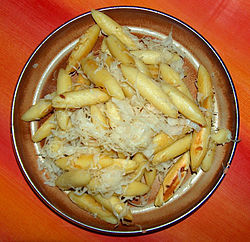Schupfnudel: Difference between revisions
Mindmatrix (talk | contribs) add {{Infobox prepared food}} |
TimSallinger (talk | contribs) m changed "elongated" to "long" |
||
| Line 19: | Line 19: | ||
==Development== |
==Development== |
||
Schupfnudeln have been known as a trooper dish since the [[Thirty Years' War]]: Out of their daily [[flour]] ration and water the soldiers formed |
Schupfnudeln have been known as a trooper dish since the [[Thirty Years' War]]: Out of their daily [[flour]] ration and water the soldiers formed long noodles which they cooked afterwards. As the potato was imported to and cultivated in Germany in the 17th century the recipe was modified and different variations emerged according to different regions. |
||
==Regional terms== |
==Regional terms== |
||
Revision as of 21:23, 30 November 2012
 | |
| Alternative names | Fingernudeln |
|---|---|
| Type | Dumpling |
| Main ingredients | Rye or wheat flour or potatoes, eggs |
Schupfnudel (meaning rolled noodle in German), also called Fingernudeln (finger noodles), is the name of a type of dumpling or thick noodle in southern German and Austrian cuisine, similar to the more internationally familiar Italian gnocchi. It is often referred to with different names in different regions in various forms. It is usually made from rye or wheat flour and egg. Since the introduction of the potato to Germany in the seventeenth century, it has also been made with that tuber. Schupfnudels are traditionally given their distinctive shape—similar to an elongated American football—through hand-shaping. They are often served as a savory dish with sauerkraut but are also served in sweet dishes.
Development
Schupfnudeln have been known as a trooper dish since the Thirty Years' War: Out of their daily flour ration and water the soldiers formed long noodles which they cooked afterwards. As the potato was imported to and cultivated in Germany in the 17th century the recipe was modified and different variations emerged according to different regions.
Regional terms
Though they can be found throughout Germany they are especially popular in the cuisine of Baden and Swabia. There they are called Schupfnudeln, which means "rolled noodles", Baunzen or even Bubenspitzle.
In Bavarian cuisine they are known as Fingernudeln (finger noodles), Dradewixpfeiferl, Kartoffel- or Erdepfebaunkerl (potato Baunkerl) or Schupfnudeln and in Upper Palatinate they are called Schopperla or Schoppala.
In the Odenwald their name is Krautnudeln (cabbage noodles) and in the Palatinate they are called Buwespitzle. The Bauchstecherla in Franconia are a bit thinner and more pointed.
A special variety of these noodles is called Mohnnudeln (poppy seed noodles) and can be found throughout Bavaria and Austria.
Preparation
The name Schupf- or Fingernudel refers to the form and shape of the noodle and not to the composition of ingredients. There is not a universally authentic recipe but many ways of preparation according to region that differ widely. Many of these variations claim to be the original and authentic Schupfnudeln.
This controversial discussion also had its effects in subject literature. Duden (reference book of German language) says, the Schupfnudel is a fried dish while Ludwig Zehetner writes in the Bavarian Dictionary one had to cook it in saltwater.
Simple recipes only use rye flour and water for the dough, but many recipes include mashed potatoes, wheatflour and egg. The dough is kneaded and then rolled into a long and thin cylindrical shape. This roll is cut into pieces of about half an inch width. These are rolled the typical shape of Schupfnudeln. Afterwards they are either cooked in salty water for about ten minutes or deep-fried. Many recipes include frying them in a pan afterwards as well.
Subsequently they are served in different ways: savoury with sage-butter or Sauerkraut or sweet with poppy seeds, sugar and cinnamon. In all cases it is necessary that the comparatively flavourless noodles incorporate the flavour of the other ingredients. Schupfnudeln can be served either as a side serving or as a main dish.
Trivia
Schupfnudeln, pan-fried with bacon bits and Sauerkraut are commonly served on public wine festivals throughout Baden and Swabia.
References
- Olli Leeb, Bavarian Cooking (1997), ISBN 978-0-7818-0561-2
- Christine Metzger, Culinaria Germany (2008), ISBN 978-0-8416-0363-9
- Nicole Stich, Delicious Days (2008), ISBN 3-8338-1222-2
